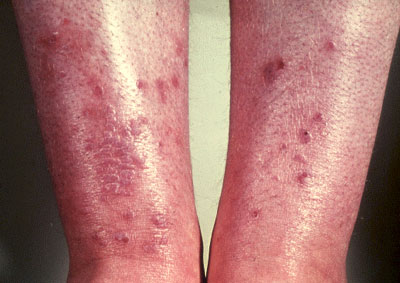|
|
|
Warts
Warts are papillomatous growths induced by the human papilloma virus (HPV). There are more than fifty different human papilloma viruses. Many of these have quite specific predilections in terms of location of the lesion. Some, such as HPV16, 18, 31, 32, 33, 34, 35, 39, 42, 51, 52, 53, 54 are carcinogenic.
Warts are very common.
Most warts on the hands, verruca vulgaris, plantar warts, and plane warts, resolve without treatment. Some of the genital warts have been associated with carcinoma of the cervix, Bowenoid papulosis, and Bowen's disease.
Warts are transmitted by skin to skin contact, although plantar warts may well be transferred from moist floors. Anogenital warts in adults are usually transmitted by sexual contact. Anogenital warts in children, while possibly indicating sexual abuse, may also be from other sites on the same patient.
Verruca vulgaris, common warts, usually due to HPV2, have a predilection to the digits. They are well circumscribed vegetations. On the palmar surface they may initially be only minimally elevated. Punctate blood vessels may be seen centrally.
Plantar warts, usually HPV1, 2, or 4, show a similar clinical appearance to verruca vulgaris. Plantar lesions, on the weight bearing surface, can be very flat, as the body weight pushes the lesion into the skin. Warts on the lateral aspects of the toe closely resemble lesions on the hand, i.e. they protrude.
Plane warts, usually due to HPV3 and 10, are well demarcated small lesions with a dull surface, only minimally elevated, most typically situated on the malar skin, and dorsum of the hands.
Genital warts, condylomata acuminata, are usually considerably more exophytic than other warts. These lesions frequently form vegetations. The oncogenic HPV types previously listed above are usually found in the genital area.
Immune compromised individuals can, instead of having only a few small warts, have often thousands of very large lesions. These patients, often transplant patients, remain very difficult to treat. Evolution to squamous cell carcinoma has been observed in some of these lesions.
Treatment:
- Papillomatous warts respond very well to liquid nitrogen cryotherapy.
- Lesions on the digits of children can also respond to topical cantharidin, with expected blister formation.
- Plantar warts can be treated with 40 % salicylic plasters, or topical solutions containing salicylic acid. Response is faster if the whitened macerated wart tissue under the plaster is pared away as with a #15 scalpel blade, before each topical treatment with the salicylic acid preparation.
- Genital warts respond well to 25 % podophyllin in tincture of benzoin. This product should not be used over extensive mucosal areas such as the vagina, as absorption can cause systemic toxicity.
- Atypical "warts", not responding to treatment, should be biopsied to rule out verrucous carcinoma or Bowen's disease.

Back to Dermatology Glossary - W Index |
Back to Dermatology Glossary Index
|